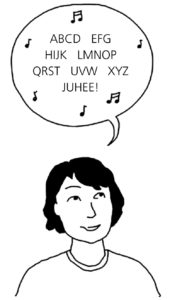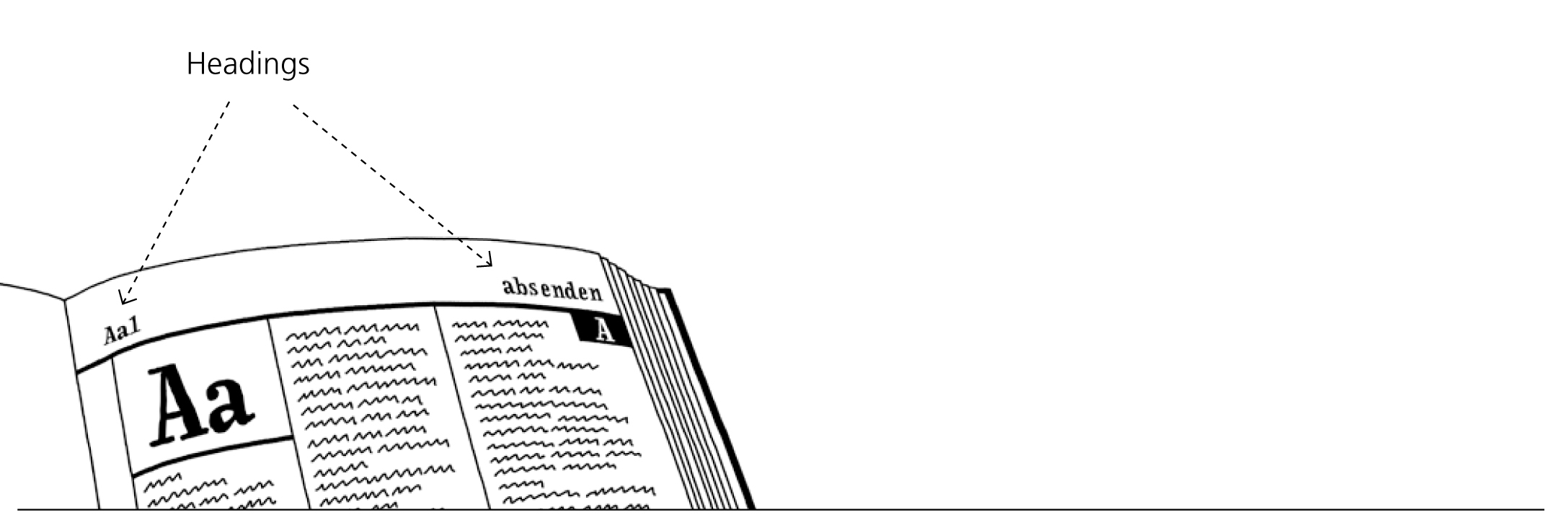Many reference works are structured in alphabetical order: dictionaries for spelling, bilingual dictionaries, encyclopedias, phone books, directories, etc. These books are highly useful to us because they contain important information. We should definitely be able to use them. However, we can only do this if we have mastered the alphabet and know a few techniques.
Caution: the sequence of the letters in the alphabet is not the same in all languages, and many languages have special letters. Discuss this in class!
Here you will find the most important “game rules” and tips for using alphabetically ordered reference works. Practicing these with someone else is more fun!
5.1
Memorize the ABC
Memorize the ABC until you can recite it by heart without problems.

Practice tips:
- Learn the letters in groups:
ABCD
EFG
HIJK
LMNOP
QRST
UVW
XYZ - Sing a song with the ABC that you know, or make one up yourselves!
- Create a long strip of paper with the ABC on it. Cover a letter with your finger without looking. Which letter does it cover up?
- Write each letter on a small piece of paper. Mix up the small pieces of paper. Then draw two of them and decide quickly: which letter precedes the other in the ABC?
- Repeat the same with three pieces and arrange them in order of the ABC.
- Take the papers, draw a piece and decide quickly: where does this letter belong, in the beginning, the middle, or towards the end of the ABC?
- Draw a piece of paper with a letter. Then try to open the dictionary approximately where the words beginning with this letter are located (e. g. words with the letter B are near the beginning, those beginning with V are near the end of the alphabet).
- Make a list (e. g. animals or plants) and put them in alphabetcial order.
5.2
This is how dictionaries and encyclopedias are constructed:
All words are arranged in alphabetical order, based on their first letter (first come the A words, then the B words, etc.: ant – bear- chameleon…).
Within the rubric beginning with the first letter, the words are ordered according to the second letter (with A -words, first come those with aa, then those with ab, then ac, ad, etc.: aardvark – abate- academy – admiral).
Within the second letter, the words are ordered according to the third letter: abet – abhore – abide – abjure, etc.
Tips for practicing (this works better in pairs!):
- Make lists with names of animals or countries that begin with the same first letter (e. g. Italy, India, Iraq, Israel), then place them in alphabetical order according to the seond letter!
- Take small pieces of paper and write words on them, taken from the dictionary that begin with the same first letter, Mix the papers and then order them according to the second and third letter.
- Take the dictionary, ask each other questions, such as: “What comes first: give or giggle?, dragon or dromedary?, forward or forget?”
M.3
Use the headings!
Headings are the words which in most dictionaries are listed at the top of each page or double page. They tell you that on this (double) page, for instance, the words “island“ to “isthmus“ are listed. This way, you can quickly decide if the word you are looking for is referenced on this page.
Tips for practicing:
- Write down a few words, then look them up in the dictionary by concentrating specifically on the word headings.
- In pairs, ask each other questions, such as: “What are the headwords on the page where ‘elephant‘ can be found?“ – “Between which word headings can the word ‘funny‘ be found?“

5.4
You must know this as well when you look up things in the dictionary:
- If compound words cannot be located, you must look up the words individually. (Example: if you are unable to find the word “snowman”, then look up “snow” and “man”).
- Nouns are always listed in the singular form. Thus, if you are searching for the plural of a noun (e. g. “apples”), you must look for it under the singular form (“apple” where you will also encounter the plural “apples”).
- Verbs are always listed in the infinitive (not conjugated). Hence, when you are looking for a verb in a certain form (e. g. “he sees”), you have to search for the verb in the infinitive or basic form (“he sees” can be found under “to see”).






